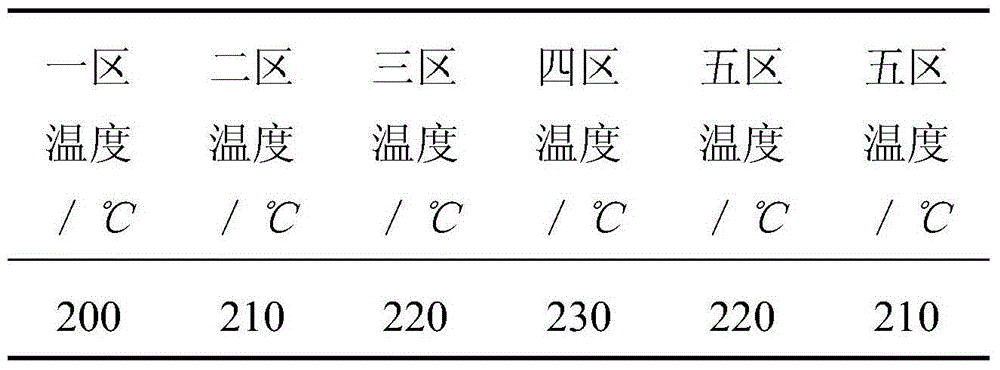Thermoplastic elastomer material and preparation method thereof
A thermoplastic elastomer and modification technology, applied in mechanical equipment, polyamide coatings, tire parts, etc., can solve the problems of large medium and long carbon chain nylon and high production cost, achieve high barrier properties, good fatigue resistance, The effect of reducing production costs
- Summary
- Abstract
- Description
- Claims
- Application Information
AI Technical Summary
Problems solved by technology
Method used
Image
Examples
Embodiment 1
[0038] Mix and stir 85kg nylon 66 salt, 15kg caprolactam, 1kg tetrakis[β-(3,5-di-tert-butyl-4-hydroxyphenyl) propionic acid] pentaerythritol, 0.6kg potassium iodide, 0.1kg phosphorous acid, and 2kg adipic acid Evenly put it into the autoclave, seal the autoclave completely, and fill the autoclave with carbon dioxide gas after vacuuming. In order to ensure that the oxygen in the autoclave is completely discharged, at least three cycles of the process are performed, and the last time the autoclave is filled with carbon dioxide gas. The pressure is 0.05MPa, turn on the induction heating, when the temperature rises to 240°C, the system pressure reaches 1.3MPa, slowly deflate, keep the pressure at about 1.3MPa, maintain this pressure for 3 hours, then slowly deflate to normal pressure, Keep the central temperature at about 250°C under normal pressure for about 0.5 hours. Preheat the outlet valve, stop heating, fill with carbon dioxide gas, open the outlet valve and discharge the mat...
Embodiment 2
[0051] 60kg nylon 66 salt, 40kg caprolactam, 0.5kg (β-(3,5-di-tert-butyl-4-hydroxyphenyl) octadecyl propionate, 0.6kg (phosphite tris (2,4-di tert-butylphenyl) ester), 0.5kg cuprous iodide, and 0.8kg adipic acid are mixed and stirred evenly and then added to the autoclave, the autoclave is completely sealed, and after vacuuming, carbon dioxide gas is filled, in order to ensure that the autoclave The oxygen in the tank is completely exhausted, at least 3 cycles of the process, after the last filling of carbon dioxide gas, the pressure in the kettle is 0.05MPa, and the induction heating is turned on. When the temperature rises to 240°C and the system pressure reaches about 1.3MPa, slowly discharge Air, keep the pressure at about 1.3MPa, maintain this pressure for 0.5 hours, then slowly deflate to normal pressure, keep the center temperature at about 250°C at normal pressure for about 1 hour, preheat the outlet valve, stop heating, Inflate with carbon dioxide gas, open the discha...
Embodiment 3
[0065] 90kg nylon 66 salt, 10kg caprolactam, 2.5kg β-(3,5-di-tert-butyl-4-hydroxyphenyl) octadecyl propionate, 2.5kg tris(2,4-di-tert-butyl phosphite) Phenyl) ester, 0.1kg cuprous iodide, 2kg sebacic acid are mixed and stirred evenly and then added in the autoclave, the autoclave is completely sealed, and after vacuuming, carbon dioxide gas is filled, in order to ensure that the oxygen in the autoclave is completely discharged, Carry out at least 3 cycles of the process. After filling the carbon dioxide gas for the last time, the pressure in the kettle is 0.05MPa. Turn on the induction heating. When the temperature rises to 230°C and the system pressure reaches about 1.3MPa, slowly release the gas and keep the pressure at About 1.3MPa, maintain this pressure for 2 hours, then slowly deflate to normal pressure, keep the center temperature at about 250°C at normal pressure for about 1 hour, preheat the outlet valve, stop heating, fill with carbon dioxide gas, and open The materi...
PUM
| Property | Measurement | Unit |
|---|---|---|
| melting point | aaaaa | aaaaa |
Abstract
Description
Claims
Application Information
 Login to View More
Login to View More - Generate Ideas
- Intellectual Property
- Life Sciences
- Materials
- Tech Scout
- Unparalleled Data Quality
- Higher Quality Content
- 60% Fewer Hallucinations
Browse by: Latest US Patents, China's latest patents, Technical Efficacy Thesaurus, Application Domain, Technology Topic, Popular Technical Reports.
© 2025 PatSnap. All rights reserved.Legal|Privacy policy|Modern Slavery Act Transparency Statement|Sitemap|About US| Contact US: help@patsnap.com



